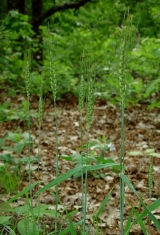- Δημοσιεύσεις: 452
- Ληφθείσες Ευχαριστίες 84
Χαρουπιά!
- fanish1
-
 Συντάκτης θέματος
Συντάκτης θέματος
- Αποσυνδεμένος
- Αρχαίος
-

Καιρό τώρα έλεγα να φυτέψω σε ένα σημείο του κήπου μου μια χαρουπιά. Προχθές βρέθηκα σε ένα φυτώριο και είδα σε ένα σημείο φυτώρια χαρουπιάς. Ρώτησα τον υπεύθυνο αν είναι χαρουπιά που κάνει χαρουπιά και μου απάντησε ότι δεν το γνωρίζει αυτό επειδή είναι από σπόρο. Πρέπει λέει να περιμένουμε να μεγαλώσει για να φανεί αν θα κάνει χαρουπια. Απλά θεωρώ λίγο τραβηγμένο να περιμένω ίσως και πέντε χρόνια για να δω αν είναι αυτό που ήθελα. Ο άνθρωπος βέβαια προς τιμήν του μου είπε την αλήθεια ίσως. Είναι όντως έτσι η να ψάξω και άλλου να αγοράσω άλλη? Γνωρίζει κανένας σας?
Παρακαλούμε Σύνδεση για να συμμετάσχετε στη συζήτηση.
- fanish1
-
 Συντάκτης θέματος
Συντάκτης θέματος
- Αποσυνδεμένος
- Αρχαίος
-

- Δημοσιεύσεις: 452
- Ληφθείσες Ευχαριστίες 84
- fanish1
-
 Συντάκτης θέματος
Συντάκτης θέματος
- Αποσυνδεμένος
- Αρχαίος
-

- Δημοσιεύσεις: 452
- Ληφθείσες Ευχαριστίες 84
Παρακαλούμε Σύνδεση για να συμμετάσχετε στη συζήτηση.
- xqtr
-

- Αποσυνδεμένος
- Σχετικά Νέος
-

- Δημοσιεύσεις: 21
- Ληφθείσες Ευχαριστίες 5
Παρακαλούμε Σύνδεση για να συμμετάσχετε στη συζήτηση.
- fanish1
-
 Συντάκτης θέματος
Συντάκτης θέματος
- Αποσυνδεμένος
- Αρχαίος
-

- Δημοσιεύσεις: 452
- Ληφθείσες Ευχαριστίες 84
- seliniotis
-

- Αποσυνδεμένος
- Νέος
-

- Δημοσιεύσεις: 4
- Ληφθείσες Ευχαριστίες 0
Παρακαλούμε Σύνδεση για να συμμετάσχετε στη συζήτηση.
- fanish1
-
 Συντάκτης θέματος
Συντάκτης θέματος
- Αποσυνδεμένος
- Αρχαίος
-

- Δημοσιεύσεις: 452
- Ληφθείσες Ευχαριστίες 84
- xqtr
-

- Αποσυνδεμένος
- Σχετικά Νέος
-

- Δημοσιεύσεις: 21
- Ληφθείσες Ευχαριστίες 5
Cultivation details
Requires a very sunny position in any well-drained moderately fertile soil[200]. Does well in calcareous, gravelly or rocky soils[132, 166]. Tolerates salt laden air[132]. Tolerates a pH in the range 6.2 to 8.6. The tree is very drought resistant, thriving even under arid conditions, the roots penetrating deep into the soil to find moisture[4, 64, 132, 200]. This species is not very hardy in Britain but it succeeds outdoors in favoured areas of S. Cornwall[1], tolerating temperatures down to about -5°c when in a suitable position[200]. The young growth in spring, even on mature plants, is frost-tender and so it is best to grow the plants in a position sheltered from the early morning sun[K]. The carob is frequently cultivated in warm temperate zones for its edible seed and seed pods[1]. Mature trees in a suitable environment can yield up to 400 kilos of seedpods annually[64]. There are named varieties with thicker pods[64, 183]. Seeds are unlikely to be produced in Britain since the tree is so near (if not beyond) the limits of its cultivation[K]. The seed is very uniform in size and weight, it was the original 'carat' weight of jewellers[1, 89]. This species has a symbiotic relationship with certain soil bacteria, these bacteria form nodules on the roots and fix atmospheric nitrogen. Some of this nitrogen is utilized by the growing plant but some can also be used by other plants growing nearby[200].
Propagation
Seed - pre-soak for 24 hours in warm water prior to sowing. If the seed has not swollen then give it another soaking in warm water until it does swell up. Sow in a greenhouse in April[200]. Germination should take place within 2 months. As soon as they are large enough to handle, prick the seedlings out into individual deep pots and grow them on in a greenhouse for at least their first winter. Plant them out into their permanent positions in late spring or early summer, after the last expected frosts. Give them some protection from the cold for their first few winters outdoors.
www.pfaf.org/user/Plant.aspx?LatinName=Ceratonia+siliqua
Παρακαλούμε Σύνδεση για να συμμετάσχετε στη συζήτηση.
- fanish1
-
 Συντάκτης θέματος
Συντάκτης θέματος
- Αποσυνδεμένος
- Αρχαίος
-

- Δημοσιεύσεις: 452
- Ληφθείσες Ευχαριστίες 84
- antilogos
-

- Αποσυνδεμένος
- Ο χρήστης είναι μπλοκαρισμένος
-

- Δημοσιεύσεις: 88
- Ληφθείσες Ευχαριστίες 69
Παρακαλούμε Σύνδεση για να συμμετάσχετε στη συζήτηση.
